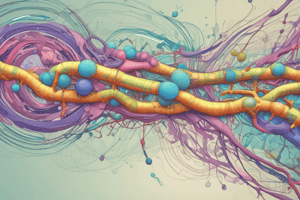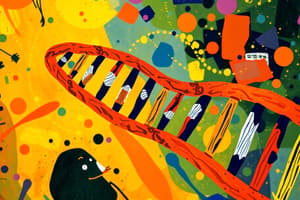Podcast
Questions and Answers
What is the primary function of exons in eukaryotic genes?
What is the primary function of exons in eukaryotic genes?
- Facilitate removal of introns
- Code for proteins (correct)
- Act as regulatory regions
- Serve as non-protein-coding regions
Which process involves the removal of intronic sequences and joining of exonic regions in eukaryotic gene expression?
Which process involves the removal of intronic sequences and joining of exonic regions in eukaryotic gene expression?
- Replication
- Transcription
- Translation
- Splicing (correct)
What is the role of introns in eukaryotic genes?
What is the role of introns in eukaryotic genes?
- Code for proteins
- Serve as non-protein-coding regions (correct)
- Facilitate mRNA transport
- Encode regulatory proteins
Which complex is responsible for recognizing specific splice sites within introns during splicing?
Which complex is responsible for recognizing specific splice sites within introns during splicing?
In eukaryotic genes, what are regulatory regions like enhancers and promoters responsible for?
In eukaryotic genes, what are regulatory regions like enhancers and promoters responsible for?
What is the main outcome of splicing in eukaryotic gene expression?
What is the main outcome of splicing in eukaryotic gene expression?
What is the primary function of splicing in eukaryotic gene expression?
What is the primary function of splicing in eukaryotic gene expression?
Which statement about enhancers is correct?
Which statement about enhancers is correct?
What is the primary function of promoters in gene expression?
What is the primary function of promoters in gene expression?
How do enhancers facilitate transcription initiation?
How do enhancers facilitate transcription initiation?
Which of the following is NOT a characteristic of exons?
Which of the following is NOT a characteristic of exons?
What is the relationship between promoters and enhancers in gene regulation?
What is the relationship between promoters and enhancers in gene regulation?
Flashcards are hidden until you start studying
Study Notes
Eukaryotic Gene Structure: Exons, Introns, Splicing, Enhancers, and Promoters
Overview
Understanding the structure and function of eukaryotic genes is essential for understanding various biological phenomena and processes. In eukaryotes, genes consist of exons, which encode proteins, and introns, which are non-protein-coding regions that need to be removed before maturation. This process is facilitated by the complex splicing machinery that recognizes specific sequences and removes introns, transforming precursor messenger RNAs (pre-mRNAs) into mature mRNAs. Additionally, eukaryotic genes feature regulatory regions, such as enhancers and promoters, which play crucial roles in gene expression.
Exons and Introns
Exons are encoding regions within eukaryotic genes that are included in the mature mRNA, resulting in the formation of proteins. In contrast, introns are intervening sequences that are excised by the splicing machinery during the maturation process. Introns are present in most eukaryotic genes, and their removal allows for the production of a functional mature mRNA that can ultimately lead to protein synthesis.
Splicing
Splicing is the essential step whereby precursor mRNAs (pre-mRNAs) are processed to remove intronic sequences and join exonic regions together. This process involves the recognition of specific splice sites within introns by the spliceosome complex, which cleaves the RNA molecule at these sites. By removing introns and connecting exons, splicing generates a continuous sequence of exons that forms the mature mRNA.
Enhancers
Enhancers are DNA elements that typically function as positive regulatory sequences that increase gene expression. They can be located thousands of base pairs away from transcription start sites, either upstream or downstream from a gene. Activator proteins bind to enhancer sequences, causing DNA loops that bring them into physical proximity with RNA polymerase and other promoters, thereby facilitating transcription initiation.
Promoters
Promoters are sites on DNA where transcription initiation occurs. They are usually located near the beginning of the coding region of a gene and contain binding sites for RNA polymerase and various regulatory proteins. When bound to these factors, the promoter facilitates the assembly of the preinitiation complex, resulting in the formation of an elongating transcript.
Conclusion
Understanding the structure and function of eukaryotic genes, including exons, introns, splicing mechanisms, and regulatory elements such as enhancers and promoters, provides valuable insights into the fundamental processes of gene expression and its regulation. These components contribute significantly to the complexity of eukaryotic genetic systems, enabling the production of diverse proteins and adaptive responses to environmental changes.
Studying That Suits You
Use AI to generate personalized quizzes and flashcards to suit your learning preferences.




